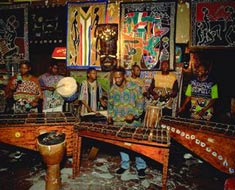The meat of the matter
The braai is where the paths of black and white
intersect gastronomically most often. Meat roasted over an open fire and
mieliepap served with tomato, onion and chillies, as a gravy or a relish -
it is a shared taste.
So is the national love of dried meat in its current form, biltong.
Who first preserved excess meat from
the hunt by smearing it with spices and hanging it out to dry? In this
semi-arid country, the San would almost certainly have dried a portion of
meat from each kill as insurance against lean times.
Black Africans have traditionally preserved extra meat by drying it in strips, a handy shape for dropping into the stew. The Dutch brought the recipe for tassal meat from the Old World, rubbing strips of meat with salt, pepper and coriander, covering them with vinegar to preserve them. They
later added saltpetre to the mix, sprinkled vinegar over and hung the meat
up to dry. The Voortrekkers made of this customary food a delicacy, using
venison, beef, ostrich - whatever they could find.
In South Africa, it is unthinkable to set out on a family vacation without
a supply of biltong; and watching rugby - either on television or at the
grounds - is not the same without the stuff in some form, in strips or in
slices.
There are many variations. Sometimes, in the old Dutch fashion, the meat is
dipped in vinegar, with saltpetre and brown sugar in the mix. If it's
venison, often juniper berries and ground spices are rubbed in. The meat is
hung anywhere from five days to a fortnight, and it lasts a very long time.


| 





